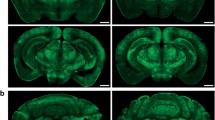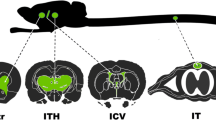Abstract
Adeno-associated virus (AAV)-PHP.B, a capsid variant of AAV serotype 9, is highly permeable to the blood-brain barrier. A major obstacle to the systemic use of AAV-PHP.B is the generation of neutralizing antibodies (NAbs); however, temporal profiles of NAb production after exposure to AAV-PHP.B, and the influence on later AAV-PHP.B administration, remains unknown. To address these, AAV-PHP.Bs expressing either GFP or mCherry by neuron-specific or astrocyte-specific promoters were intravenously administered to mice at various intervals, and brain expression was examined. Injection of two AAV-PHP.Bs, separated temporally, showed that as little as a 1-day interval between injections resulted in a significant decrease in expression of the second transgene, with a complete loss of expression after 7 days, paralleling an increase in serum NAb titers. Brain parenchymal injection was explored to circumvent the presence of NAbs. Mice systemically pre-treated with an AAV-PHP.B were injected intra-cerebrally with an AAV-PHP.B expressing GFP. After 2 weeks, marked GFP expression in the cerebellum was evident, showing that pre-existing NAbs did not affect the AAV-PHP.B directly injected into the brain. In contrast, reversing the injection order, i.e., cerebellar injection followed by systemic injection, completely eliminated expression of the second transgene. We confirmed that intra-cerebellar injection produced NAbs in the serum, but not in the cerebrospinal fluid (CSF). Our results indicate that the preclusion of brain transduction by a second AAV-PHP.B administration begins from the first day following systemic injection and is established within 1 week. Serum NAbs can be avoided by directly injecting AAV-PHP.Bs into brain tissue.






Similar content being viewed by others
References
Atchison RW, Casto BC, Hammon WM (1965) Adenovirus-associated defective virus particles. Science (New York, NY) 149(3685):754–756
Weitzman MD, Linden RM (2011) Adeno-associated virus biology. Methods Mol Biol (Clifton, NJ) 807:1–23. https://doi.org/10.1007/978-1-61779-370-7_1
Saraiva J, Nobre RJ, Pereira de Almeida L (2016) Gene therapy for the CNS using AAVs: the impact of systemic delivery by AAV9. J Control Release 241:94–109. https://doi.org/10.1016/j.jconrel.2016.09.011
Srivastava A (2016) In vivo tissue-tropism of adeno-associated viral vectors. Curr Opin Virol 21:75–80. https://doi.org/10.1016/j.coviro.2016.08.003
Arsenault J, Gholizadeh S, Niibori Y, Pacey LK, Halder SK, Koxhioni E, Konno A, Hirai H et al (2016) FMRP expression levels in mouse central nervous system neurons determine behavioral phenotype. Hum Gene Ther 27(12):982–996. https://doi.org/10.1089/hum.2016.090
Huda F, Konno A, Matsuzaki Y, Goenawan H, Miyake K, Shimada T, Hirai H (2014) Distinct transduction profiles in the CNS via three injection routes of AAV9 and the application to generation of a neurodegenerative mouse model. Mol Ther Methods Clin Dev Article number: 14032. https://doi.org/10.1038/mtm.2014.32
Matsuzaki Y, Konno A, Mukai R, Honda F, Hirato M, Yoshimoto Y, Hirai H (2016) Transduction profile of the marmoset central nervous system using adeno-associated virus serotype 9 vectors. Mol Neurobiol 54:1745–1758. https://doi.org/10.1007/s12035-016-9777-6
Bevan AK, Duque S, Foust KD, Morales PR, Braun L, Schmelzer L, Chan CM, McCrate M et al (2011) Systemic gene delivery in large species for targeting spinal cord, brain, and peripheral tissues for pediatric disorders. Mol Ther 19(11):1971–1980. https://doi.org/10.1038/mt.2011.157
Gray SJ, Matagne V, Bachaboina L, Yadav S, Ojeda SR, Samulski RJ (2011) Preclinical differences of intravascular AAV9 delivery to neurons and glia: a comparative study of adult mice and nonhuman primates. Mol Ther 19(6):1058–1069. https://doi.org/10.1038/mt.2011.72
Samaranch L, Salegio EA, San Sebastian W, Kells AP, Foust KD, Bringas JR, Lamarre C, Forsayeth J et al (2012) Adeno-associated virus serotype 9 transduction in the central nervous system of nonhuman primates. Hum Gene Ther 23(4):382–389. https://doi.org/10.1089/hum.2011.200
Deverman BE, Pravdo PL, Simpson BP, Kumar SR, Chan KY, Banerjee A, Wu WL, Yang B et al (2016) Cre-dependent selection yields AAV variants for widespread gene transfer to the adult brain. Nat Biotechnol 34(2):204–209. https://doi.org/10.1038/nbt.3440
Nitta K, Matsuzaki Y, Konno A, Hirai H (2017) Minimal Purkinje cell-specific PCP2/L7 promoter virally available for rodents and non-human primates. Mol Ther Methods Clin Dev 6:159–170. https://doi.org/10.1016/j.omtm.2017.07.006
Shinohara Y, Konno A, Takahashi N, Matsuzaki Y, Kishi S, Hirai H (2016) Viral vector-based dissection of marmoset GFAP promoter in mouse and marmoset brains. PLoS One 11(8):e0162023. https://doi.org/10.1371/journal.pone.0162023
Yeo S, Bandyopadhyay S, Messing A, Brenner M (2013) Transgenic analysis of GFAP promoter elements. Glia 61(9):1488–1499. https://doi.org/10.1002/glia.22536
Shinohara Y, Ohtani T, Konno A, Hirai H (2017) Viral vector-based evaluation of regulatory regions in the neuron-specific enolase (NSE) promoter in mouse cerebellum in vivo. Cerebellum (London, England). https://doi.org/10.1007/s12311-017-0866-5
Matsuzaki Y, Konno A, Mochizuki R, Shinohara Y, Nitta K, Okada Y, Hirai H (2018) Intravenous administration of the adeno-associated virus-PHP.B capsid fails to upregulate transduction efficiency in the marmoset brain. Neurosci Lett 665:182–188. https://doi.org/10.1016/j.neulet.2017.11.049
Samaranch L, Blits B, San Sebastian W, Hadaczek P, Bringas J, Sudhakar V, Macayan M, Pivirotto PJ et al (2017) MR-guided parenchymal delivery of adeno-associated viral vector serotype 5 in non-human primate brain. Gene Ther 24(4):253–261. https://doi.org/10.1038/gt.2017.14
Hordeaux J, Wang Q, Katz N, Buza EL, Bell P, Wilson JM (2018) The neurotropic properties of AAV-PHP.B are limited to C57BL/6J mice. Mol Ther 26(3):664–668. https://doi.org/10.1016/j.ymthe.2018.01.018
Guzman MG, Halstead SB, Artsob H, Buchy P, Farrar J, Gubler DJ, Hunsperger E, Kroeger A et al (2010) Dengue: a continuing global threat. Nat Rev Microbiol 8(12 Suppl):S7–S16. https://doi.org/10.1038/nrmicro2460
Jiang L, Zhang H, Dizhoor AM, Boye SE, Hauswirth WW, Frederick JM, Baehr W (2011) Long-term RNA interference gene therapy in a dominant retinitis pigmentosa mouse model. Proc Natl Acad Sci U S A 108(45):18476–18481. https://doi.org/10.1073/pnas.1112758108
Sehara Y, Fujimoto KI, Ikeguchi K, Katakai Y, Ono F, Takino N, Ito M, Ozawa K et al (2017) Persistent expression of dopamine-synthesizing enzymes 15 years after gene transfer in a primate model of Parkinson’s disease. Human gene therapy Clinical development 28(2):74–79. https://doi.org/10.1089/humc.2017.010
Bacyinski A, Xu M, Wang W, Hu J (2017) The Paravascular pathway for brain waste clearance: current understanding, significance and controversy. Front Neuroanat 11:101. https://doi.org/10.3389/fnana.2017.00101
Louveau A, Plog BA, Antila S, Alitalo K, Nedergaard M, Kipnis J (2017) Understanding the functions and relationships of the glymphatic system and meningeal lymphatics. J Clin Invest 127(9):3210–3219. https://doi.org/10.1172/jci90603
Acknowledgments
We thank Asako Ohnishi and Junko Sugiyama for the viral vector production and the maintenance of mice.
Funding
This research was supported by the program for Brain Mapping by Integrated Neurotechnologies for Disease Studies (Brain/MINDS) from Japan Agency for Medical Research and Development, AMED, under the Grant Number JP17dm0207057h0001 (to H. Hirai), and partially supported by JSPS KAKENHI Grant Number 15K18330 (to A. Konno) and 17K14929 (to Y. Matsuzaki).
Author information
Authors and Affiliations
Contributions
YS designed and performed the experiments, analyzed the data, and drafted the manuscript. AK designed the experiments and contributed to production of AAV vectors. KN (ELISA), YM (experiments using rats), and HY (immunohistochemistry) performed the experiments. JS and KH supervised the ELISA experiment. HH designed the experiments and wrote the manuscript.
Corresponding author
Ethics declarations
Competing Interests
The authors declare that they have no competing interests.
Electronic Supplementary Material
ESM 1
(PDF 713 kb)
Rights and permissions
About this article
Cite this article
Shinohara, Y., Konno, A., Nitta, K. et al. Effects of Neutralizing Antibody Production on AAV-PHP.B-Mediated Transduction of the Mouse Central Nervous System. Mol Neurobiol 56, 4203–4214 (2019). https://doi.org/10.1007/s12035-018-1366-4
Received:
Accepted:
Published:
Issue Date:
DOI: https://doi.org/10.1007/s12035-018-1366-4




